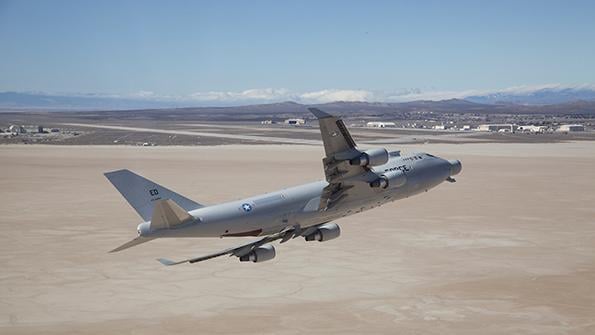This article is published in Aviation Week & Space Technology and is free to read until Jul 19, 2024. If you want to read more articles from this publication, please click the link to subscribe.

The YAL-1 conducted its final flight in 2012 before being scrapped two years later. Now the MDA is revisiting the potential for airborne lasers.
Ten years after the demise of the Boeing 747-based chemical laser and four years after the Missile Defense Agency killed another program, the agency again is looking into the possibility of an airborne laser to protect against incoming threats.
In fiscal 2026, the Missile Defense Agency (MDA) expects to spend about $11 million on the effort, following recent reductions in the size and weight of directed-energy systems along with increased power, MDA Director U.S. Air Force Lt. Gen. Heath Collins said.
- Limited funding to begin in 2026
- MDA to look first at tracking and characterization
“We do see a future, and we’ve had an independent team come and take a look, and they’ve recommended that there’s some things that we can do,” he said at a Center for Strategic and International Studies event in Washington June 6. “And so this money is the beginning of a foray back into an airborne level of directed energy.”
Collins noted that the MDA has stepped away from directed energy, while the rest of the Defense Department has assumed a broader set of science and technology efforts to mature it.
An MDA spokesperson said in a follow-up statement that the agency is planning for follow-on spending beyond fiscal 2026, although the specific amounts will not be released until future budgets are announced.
“MDA is not proposing a program of record for an airborne laser,” the spokesperson explained. “What we are doing is focusing on long-range detection and tracking demonstrations as well as reducing directed-energy technology risk for various components. So as the technology advances and is proven, we can spiral-develop advanced capabilities for more challenging missions.”
The Pentagon’s highest-profile effort in this area was the Boeing YAL-1 Airborne Laser, a large chemical laser mounted on the nose of a 747 that in 2010 demonstrated in a test that it could destroy boosting ballistic missiles. However, the massive laser and large cooling required proved impractical, and the program was canceled. The 747 has since been scrapped, with its nose-mounted laser soon to go on display at the Museum of the U.S. Air Force in Dayton, Ohio.
The MDA brought the concept back in 2016, issuing a request for information for fielding a 5,000-lb. laser weapon on an uncrewed aircraft system by fiscal 2023. What became the Low-Power Laser Demonstrator program progressed to a critical design review, but funding was zeroed out in the fiscal 2021 request after then-Undersecretary of Defense for Research and Engineering Michael Griffin decided there was no feasible path forward for an operational system.
Despite this cancellation, Griffin’s office moved ahead with a separate effort, the High-Energy Laser Scaling Initiative (HELSI), which has since evolved to ground- and ship-based variants for each of the three services. Lockheed Martin, which is developing a system for the U.S. Army’s Indirect Fires Protection Capability-High Energy Laser, said in July 2023 that it was working on a second phase, targeting a 500-kW laser while also focusing on efficiency, size, weight and volume. For the Navy, nLight’s Nutronics subsidiary is developing a 300-kW-class laser under a May 2023 contract awarded after a 2022 demonstration.
Heidi Shyu, the current undersecretary of defense for research and engineering, said in April that the Air Force’s version will be delivered after the Navy’s. While most of the details are classified, Shyu confirmed the Air Force’s system will also be ground-based. General Atomics Electromagnetic Systems has been linked to that program’s development.
Documents supporting the MDA’s fiscal 2025 budget request show that the agency conducted a High-Energy Laser Unmanned Aerial Vehicle Design Update Study last year. Further back, the agency’s fiscal 2023 budget included the last request for funding for Directed Energy Demonstrator Development, which addressed “technology risk reduction and maturation for high-powered strategic lasers, beam control, lethality and related technologies.”
While Collins says the maturation of directed energy has shown its feasibility to return to airborne operations, the technology is not quite ready to return to the YAL-1’s goal of killing a missile.
“We will likely start—and plan to start—more in the tracking, characterization side forward,” Collins says. “And then as the technology ramp-up that we’re seeing comes to fruition, we will continue to look at potential lethal effects of directed energy as we go forward.”





